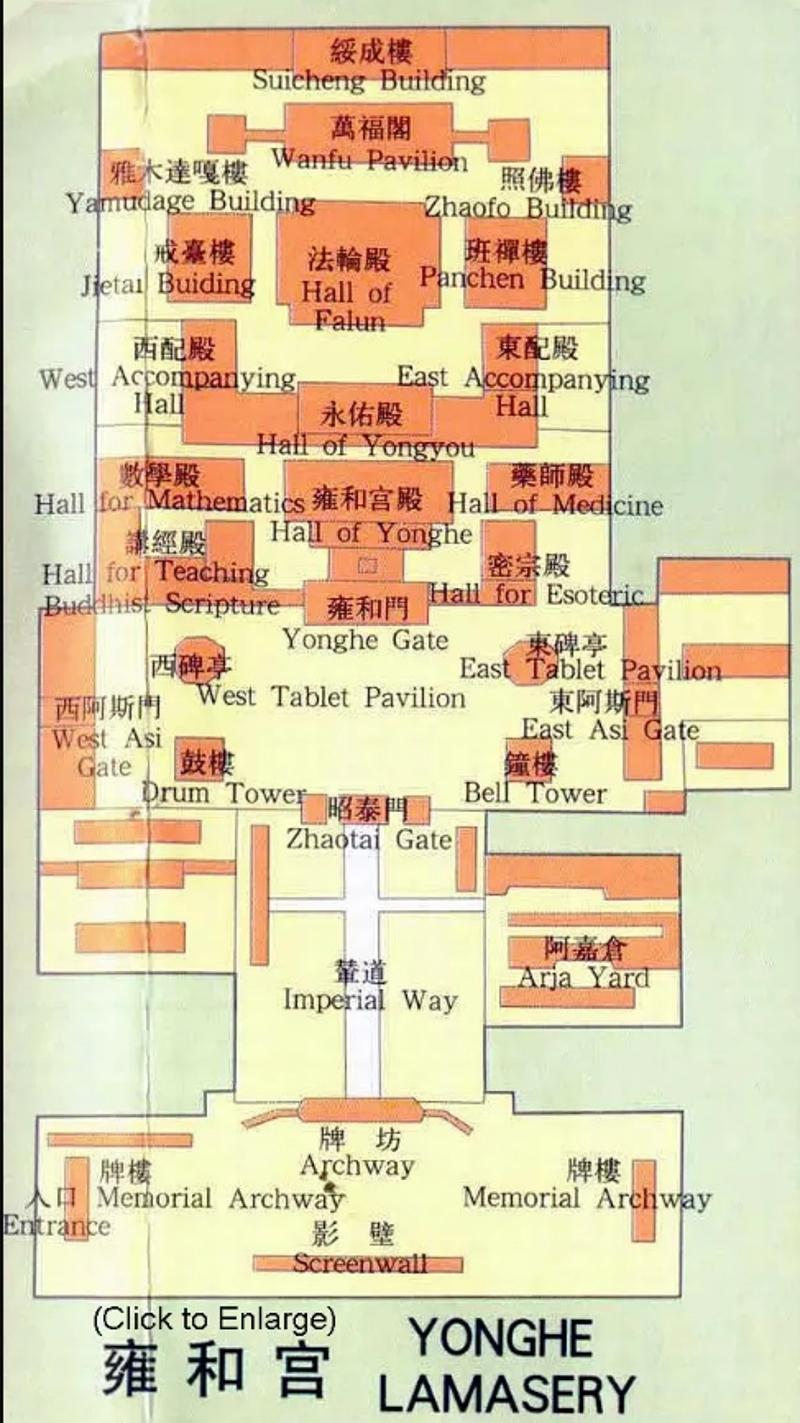The Layout of Yonghe Temple: A Magnificent Buddhist Temple
Yonghe Temple, also known as Yonghe Lamasery, is located on Yonghegong Street, Dongcheng District, Beijing, China. Situated along the north-south central axis, Yonghe Temple stretches for 480 meters (1,570 feet) with an area of 66,400 square meters (25,600 square miles). The main gate, Zhengyangmen, is located at the southern end of this axis, preceded by three archways. As one of Beijing's famous ancient architectural complexes, it boasts a sophisticated layout, carrying rich historical and cultural significance.

Reference: Yonghe Temple: A Cultural Gem of Buddhism in Beijing
1. Location and Scale of Yonghe Temple
Yonghe Temple is arranged along the north-south central axis, total length of 480 meters, and covering an area of 66,400 square meters. The main gate, Zhengyangmen, is located at the southern end of the central axis, preceded by three archways, creating a solemn and dignified atmosphere.
2. Historical Background of Yonghe Temple
Originally serving as an imperial palace during the Qing Dynasty, Yonghe Temple also functioned as the administrative center for Tibetan Buddhism by the Qing government. It was first built in the 33rd year of the Kangxi Emperor's reign (1694), undergoing expansions and renovations under subsequent emperors, and officially converted into a temple in the 9th year of the Qianlong Emperor's reign (1744).
3. Architectural Layout of Yonghe Temple
- Front of the Temple: Features archways and a carriage passage, consisting of Zhengyangmen, Bell Tower, Drum Tower, and other structures. Among them, Zhengyangmen serves as the main entrance, symbolizing significance and ceremonial importance.
- Layout of the Seven Halls and Temples: Includes Zhengyangmen, Bell Tower, Drum Tower, Yonghe Gate, Yonghe Palace, Lecture Hall, and Tantra Hall. These buildings are arranged sequentially along the central axis, showcasing the overall layout and structure of the temple.
- Division of the Temple Complex: Divided into east, central, and west sections. While the eastern part suffered damage from fires, and the western part was affected by road construction, the central part retains relatively intact buildings, preserving the original appearance of the temple.
4. Functions and Features of Each Hall in Yonghe Temple
- Zhengyangmen: Serving as the main entrance, it welcomes believers and visitors, holding symbolic significance.
- Yonghe Palace: Formerly the Silver Peace Hall of the royal palace, it now houses statues of Buddhas and religious relics, serving as one of the main buildings of the temple.
- Yonghe Palace: Originally Yongzheng's study and bedroom, it is now used for worship and study.
- Dharma Wheel Hall: Modeled after the Rain Flower Pavilion of the Forbidden City, it is primarily used for study and practice.
- Lecture Hall, Tantra Hall, Wheel of Time Hall, Medicine Buddha Hall: These four halls are used for different forms of study and religious activities, reflecting the teachings and traditions of Tibetan Buddhism.
- Pavilion of Ten Thousand Blessings: Serves as a place of worship for Buddha statues and hosts religious ceremonies.
5. Cultural and Religious Activities at Yonghe Temple
- Cultural Exchange: As a center of Tibetan Buddhism studies, Yonghe Temple attracts lamas from different ethnic groups, promoting cultural exchange and integration.
- Religious Ceremonies: Every June 6th of the lunar calendar, monks at Yonghe Temple recite and display the classics "Ganzhuer" and "Danzhuer," holding various religious rituals and ceremonies.
- Historical Relics: Yonghe Temple preserves many historical relics and precious cultural artifacts, such as ancient bronze incense burners and inscriptions written by Emperor Qianlong, reflecting its long history and cultural heritage.
In conclusion, Yonghe Temple, as a Buddhist temple with a long history and profound cultural heritage, its architectural layout and functional zoning reflect its status as a center for Tibetan Buddhist studies and religious activities, as well as showcasing the exquisite craftsmanship of traditional Chinese architecture and the wide-ranging influence of religious beliefs.
Q&A:
What is the significance of Zhengyangmen in Yonghe Temple?
Zhengyangmen serves as the main entrance of Yonghe Temple, symbolizing significance and ceremonial importance. It welcomes believers and visitors, marking the beginning of the spiritual journey within the temple complex.
How is Yonghe Temple divided architecturally?
Yonghe Temple is divided into three parts: east, central, and west. The eastern part suffered damage from fires, while the western part was affected by road construction. The central part retains relatively intact buildings, preserving the original appearance of the temple.
What are the primary functions of the Lecture Hall and the Tantra Hall in Yonghe Temple?
The Lecture Hall is primarily used for the study of Buddhist scriptures and teachings, while the Tantra Hall is dedicated to the practice of Tibetan Buddhist tantric rituals and meditation techniques.
note: This return of all, without the author's permission, may not be reproduced